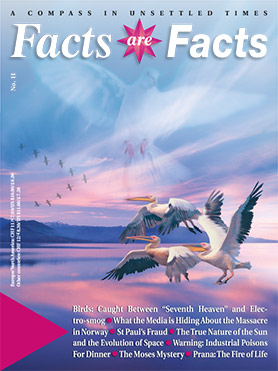Birds of a Heavenly Feather
Birds are people too—even if they don’t drive cars, have savings accounts, or go shopping every weekend. Maybe they’re happier and more at peace than we are. And what we really don’t want to admit: They’re here to make us happy!

The reason birds can fly and we can’t is simply that they have perfect faith, for to have faith is to have wings. - Sir James Matthew Barrie (1860–1937), creator of “Peter Pan”
So Abu stands there—just as happy in the papyrus swamps—and contemplates. About, for example, the connections between religions—and especially deeply about the relationship between Judaism, Islam, and Christianity. He does this because all of these religions were born, so to speak, in the area of his homeland. Let’s listen to the conclusions Abu Markub has reached: “You all forget, in these rather patriarchal religions, the feminine. In these religions the feminine is presented almost exclusively as either virgin or whore. Woman is not greatly valued in these religions. That is not right. The culture of the Southern Nile, of the White Nile, understood this. They successfully coupled matriarchal and patriarchal structures. I think about that.”
Abu Markub is familiar with the seven-hundred year old matriarchal culture of the Kush Kingdom that blossomed along the Nile in the area of modern-day Sudan in the years before Christ. Pharaohesses reigned there and there were also pyramids, although not as large as the patriarchal structures in Northern Egypt.
Abu Markub also knows how the three monotheistic world religions could make amends to the feminine—if someone would only ask him for advice: “By learning another way to deal with sexuality. This will be decisive, since sexuality is an issue that is neither wholly sacred nor wholly obscene, but is rather part of man’s normal life, and has been for quite some time. Through your fixation on this theme—either denial on the one hand or lust on the other—contempt of woman enters into religion, and into the rest of life.” According to Abu Markub, the masculine and the feminine must finally be recognised as having equal value. “Then the fixation on the male side would be normalised and woman would be more valued. Then it would no longer be so important that a man can claim about a woman: ‘She’s mine!’ This actually hints at women’s value, if in a backhanded way—because if a woman was worthless, there would be no reason to label her a man’s property! In this respect, you should recognise that the woman is extremely valuable, but you should place her on the same level as man.”
Abu Markub is familiar with taboos. He says that the practice of genital mutilation, which is still widely practiced in Africa, has nothing to do with Islam, but comes from much older sources. “It has to do with maiming something that is actually of great worth. Woman and her vagina were seen as being especially magical. But because man begrudged woman this magic, he transferred this magic to the man through genital mutilation. Genital mutilation is a nasty practice that has nothing to do with culture.”
The German adventurer and survival expert Rüdiger Nehberg has earned special recognition around this issue. He travelled to Ethiopia, called all Islamic dignitaries and tribal leaders together and explained to them that genital mutilation had absolutely nothing to do with Islam and that nothing like it was mentioned in the Koran—thanks to him, genital mutilation was officially recognised as blasphemy. After all, Allah created humans in his image, and snipping around on their bodies would mean that man had raised himself above Allah. Nehberg even managed to have this confirmed by the highest Sunni cleric at the Al-Azhar University in Cairo. The tribal leaders are now obliged to pass this along to their peoples.
Abu Markub admits that he tried, subconsciously, to inspire Nehberg for this tremendous undertaking. “I introduced him to this issue and the appropriate people.” Abu Markub is a saint for the Africans. That is also the reason why he is not persecuted. Additionally, he is a ‘man of action’, not of words. Of course, he practises equality in a consummate manner: one time he broods, the next time his wife does. Because Abu Markub is by profession a shoebill (that is the English translation of his Arabic name) and belongs to the order pelecaniformes.
Now if you, dear reader, are thinking that we here at Facts are Facts have lost it, I could certainly understand. Although I have to pass the buck on this one and say that the Flensburger Hefte has lost it. This information comes from their third volume of Conversations with Animals.
In point of fact, we are extremely critical of all communications with higher beings or worlds—most are not what they would seem to be. But several things indicate that Verena Staël von Holstein is no spaced-out spiritualist funny bird—she studied such down to earth subjects as surveying and hydrography and worked as a programmer and water surveyor. The fact that she could already see nature spirits as a child seemed totally normal to her and she does not turn her “trade” into any kind of business—not even the business of fame. She eschews every kind of publicity and seeks to lead her life as ‘under the radar’ as possible.
When she speaks with an animal, she addresses the animal’s soul which, in more highly evolved species, absolutely demonstrates individual traits—a soul that is “actually a spiritual being with quite high standing”. “Even a single animal,” according to Staël von Holstein, “has such a soul. And we can talk with that soul. And this soul doesn’t forget. Evidence-based scientific research has already proven many times that animals, e.g. elephants, cannot forget. That is the key evidence that animals are part of the All-Knowing. They don’t usually need the All-Knowing to get through their day under normal circumstance. But when they are in the special situation of being interviewed for humans, or even for publication, then they immediately interface with the All-Knowing, because highly evolved animals are not stupid. Any cat or dog owner knows that these animals are actually quite smart. This doesn’t work with an earthworm, however. It also has a soul, but it’s almost as far removed as its self. When we spoke with lower order animals, the animal Self (i.e. the Great Animal or angel) was usually answering. Because it’s very difficult for me to make contact with the individual souls of lower animals.”

Birds of prey belong to the cadaver-removal clean-up team of the animal world. There is nothing brutal about what they do and they hunt so as to be as effective and energy saving as possible.
“Many people have asked me: How do you actually do it? And this question already contains a certain doubt. When I have visitors, they often come with this question already on their lips. But once they have witnessed how I communicate with nature spirits, this doubting question disappears. Until now, it’s never happened differently.” Moreover, the conversations speak for themselves.
When she speaks with an individual animal-soul, says Staël von Holstein, then it sometimes happens that the “Great Animal” appears as well. By “Great Animal” we mean those beings from the hierarchy of nature-angels that animate, guide, and direct the entirety of that animal species. This nature-angel is in reality that aspect which science calls “instinct”.
The nature-angel—usually referred to with the Sanskrit word “deva” (“The Shining One”)—is that aspect that communicates the right time and location to gather and migrate southwards to migratory birds. It accompanies them on their journey—and it, its soul and its energy, is also manifested in the oneness of the flock: every bird is then nothing more than a centrally-directed cell in the great flock-organism. That is also the reason why flocking birds often shake themselves and ruffle their feathers when they land—they are emerging from a cell in a whole organism back into their individuality. The flock communication takes place on the electromagnetic level and can therefore also be corrupted by a certain amount of electro-smog in the air.
So when an animal feels somewhat overwhelmed during an “interview”, the Great Animal steps in and helps answer the questions. Just as in humans, the animal’s intelligence is variously trained. Whereas, for example, the bird of paradise and the ostrich are not exactly brainiacs, woodpeckers and crows are quite smart, but not nearly as intelligent as parrots.
How the Parrot Learns to Prattle
“We are the smartest birds,” says Ferdi, a bright red macaw, proud of his kind. Parrots show just how highly evolved they are in their social behaviour. “We don’t have a leader and we manage just fine without one. We are a translucent band of brothers; we are all equals among equals. We honour age and always give preference to the aged Aras, but there is nevertheless no strife among us because we all have enough autonomous personality and don’t need to be constantly cribbing from one another. This kind of social behaviour is very rare among birds.”
Aras also don’t have a set territory. Ferdi explains why that is: “We are citizens of the world! The whole earth is our territory! We are everywhere the sun shines down. But we especially love to be where the light shines directly down one time each day. There where the sun kisses the earth once a day, the Aras find their home.” This strong sunlight in the area of the equator is also the reason for his colourful plumage. “The Aras have these gorgeous colours because the colourfulness in the tropics is tattooed into the earth at noon each day directly from above.” This connection to the light, that always has an inspirational quality, is also the reason that the Aras can learn to “speak”. Although it’s actually only imitation.
Ferdi: “I can also imitate a vacuum cleaner. When a person has a cat in the house and I imitate the vacuum cleaner, the cat disappears. Cats don’t like vacuum cleaners. Cats find vacuum cleaners atrocious. When we hear a person speak and we want to imitate it, we have to practice. We always start with the phonic components and, with time, put the pieces together the right way. We can’t imitate the entire sound of the word all at once. We keep listening and then we practise, in the way birds do. Even a blackbird incorporates melodies from other birds or human sounds into its songs when it hears them regularly.” Although the Ara can certainly discern if he is imitating something correctly or not—“otherwise I wouldn’t be able to improve by practising. What I don’t understand is the meaning.”
People’s reactions are also not unimportant to him: “It does matter to me, because I am a social animal. And so I try to motivate the beings around me to interact with me through my utterances. Normally, there are a lot of us, we sit together and cuddle and that is why we also like to spoon with people. We need physical contact. As I already said, I don’t understand what the words mean, but I do notice if people react positively or negatively to the words. If you teach me a bad word and react positively, I will think that it’s something good. My speech is not content-based, but situation-based. I can know that if I always say the same thing to a person every morning that he will react positively.” (Let it be noted that the communication with Verena Staël von Holstein takes place on a higher level than physical language. It happens extremely quickly and in supra-linguistic terms or thoughts. It is her responsibility to clothe what she has received in human language.)
Because the Aras are such social birds, it is essential that they have company when they are kept by humans. “That is why cages with solitary Aras, that no one cares about, are such dreadful things,” says Ferdi. “That is when I begin to tear my feathers out. I become melancholy and don’t want to be beautiful anymore. But if I have even a single companion in the cage or a person who really cares for me and a friendship between human and parrot develops, then I can also be a good companion for the person—and the person for me. Because, to me, people do a lot of things that seem crazy and interesting. And a person doesn’t have a beak! Why don’t you have beaks? Why do you have such an impractical mouth?”
Wolfgang Weirauch (the interviewer): “I don’t know.”
Ferdi: “You can’t hang from your mouth, you can’t crack nuts. And you don’t have as powerful a tongue as we do. We are actually quite conscious birds and a part of this consciousness is in our tongues.”
Parrot couples mate for life. And among males, there are no power struggles. “You humans should organise yourselves as we do,” advises Ferdi, the Ara. “Then you would have virtually no more strife. Our single enemy is mankind.”
Impolite: Blackbird style
That is especially tragic as the bird kingdom wants to bring joy to humans and sings their songs mostly for humans. While it’s true that the bird’s morning songs are a hymn to the sun—the Divine—that gives us a new day, they otherwise sing mankind’s restoration. Even the blackbird, whose song is only surpassed by the nightingale, says that. Usually it’s the male blackbird who sings, since the female is busy bringing up the young. And singing and brooding don’t go together, at least in the bird kingdom. “Singing is so important to us that we forget everything else while we are singing. According to your scientific understanding, singing is worthless; according to our understanding, singing is anything but worthless,” clarifies Nanine, a female blackbird, for her species.
Blackbirds have even followed humans out of the woods into their residential neighbourhoods so that people can take joy in their wonderful song: “My song only becomes really great when it is appreciated. You wouldn’t give a speech in the middle of the woods where there is no one to hear you, either. We sing to welcome the Self and the human Self is more present than ours.” Meaning, the blackbird honours the divine in Man with its song. Although they don’t mind making a few jokes as they do it! Nanine, for example, likes to imitate the sound of a bike bell: “I live here near the watermill and the son of the house especially likes to ring the bell on his bike. I learned to imitate the sound of his bell. So now, in the middle of my song, I also sing like a bike bell. I can of course also sing lyrically and quite melodiously, but I always incorporate a bike bell into my song line. And that’s kind of nice, because then the people always look around trying to find the bike.”






